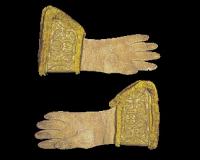‘Fit for a king’: mementoes of William of Orange (1650–1702) in Ireland
Published in Early Modern History (1500–1700), Features, Issue 2(March/April 2011), Volume 19, Williamite Wars
One of two pairs of gauntlets presented to Sir John Dillon of Lismullen, Co. Meath, by William of Orange.
In 1689 Irish men and women were drawn into the struggle between the Catholic James II and the Protestant William III for the thrones of England, Scotland and Ireland. This was the most ‘conventional’ war between the Nine Years’ War and the 1798 Rebellion in Ireland, with two major European-scale battles in the field and several long sieges of important towns.
Landing in Ireland on 14 June 1690, William spent less than three months in Ireland, although the war, of course, lasted longer. William presented some personal belongings to officers who fought for him while in Ireland, a number of which are on display in the National Museum of Ireland, including a glass decanter, a glass posset bowl, a bed coverlet and two pairs of gloves that he presented to Sir John Dillon of Lismullen, Co. Meath. According to family tradition William stayed there after the Battle of the Boyne. Another object on display in the ‘Soldiers & Chiefs’ exhibition is a presentation sword that William is believed to have given to William Bentinck, earl of Portland, in appreciation of his service at the Battle of the Boyne in 1690. Like many
The ivory lion-shaped handle of the sword presented to William Bentinck, earl of Portland.
(All images: National Museum of Ireland)

The ivory lion-shaped handle of the sword presented to William Bentinck, earl of Portland.
(All images: National Museum of Ireland)
soldiers at the time,
Bentinck, a Dutch supporter of William and his close friend, earned not only the sword but also his English title and Irish lands through his loyalty to the monarch. Today medals are awarded for bravery or for service in an army, but this tradition only started in the early nineteenth century.
The sword has an ivory handle in the shape of a lion with jewels in the eyes and gold inlay on its claws. This is a very rare sword from the Dutch East Indies, dating from 1688; indeed, it is a sword fit for a king. With the war over, under the Treaty of Limerick 18,000 of James’s Irish soldiers were allowed to leave for France, where they laid the foundations of the eighteenth-century ‘Wild Geese’ regiments. In Ireland, of course, the ‘War of the Two Kings’ provided communities both North and South with their own separate identities that have remained part of popular memory ever since. HI
Lar Joye is curator of military history at the National Museum of Ireland (Decorative Arts and History).


















